Are you questioning How to install an automatic ice maker? Is this the first you purchase an ice maker and you need to install it and also you don’t know how? Are used to calling a certified individual to install your ice maker which costs you some huge cash.
You are in the right place we’ll present to you How to install an automatic ice maker to yourself without calling you skilled we’ll show you many things related to installations of an ice maker machine.
Please comply with and read the instructions and steps below from A to Z to know How to install an automatic ice maker.

Before we begin the set up After you bought an ice maker you may unpack the ice maker.
The following items are required to install the ice maker package:
• ¼” copper supply line with shutoff valve
• ¼” brass compression nut and ferrule
• Freezer shelf (Some models usually are not equipped with the shelf). If your model doesn’t have one, contact your supplier to order one.
The copper tubing and shutoff valve can be found in a package out of your local {hardware} or plumbing supply retailer. Coil sufficient tubing at the back of the unit to permit movement for cleaning.
What tools need to install an automatic ice maker?
- Plastic Putty Knife
- PhillipsTM Screwdriver
- ¼” Socket Wrench or Nut Driver
- Needle Nose Pliers
- Adjustable Wrench
- Power Drill with PhillipsTM Bit
- Small Kitchen Knife
What are the kit parts of an automatic ice maker?
- Ice Maker Qty: 1
- Ice Container Qty: 1
- Plastic Water Supply Tubing Qty: 1
- Self-tapping Screw Qty: 2
- Long Mounting Screw Qty: 2
- Leveling Bracket Screw Qty: 1
- Leveling Bracket Qty: 1
- Steel Clamp Qty: 1
- Plastic Clamp Qty: 2
- Water Valve Qty: 1
- Tube Seal Qty: 1
- Water Inlet Tube Qty: 1
How to install an automatic ice maker?
Ice Maker Installation Instructions
Step1. Unplug the ice maker machine from an electrical outlet.
Step 2. Remove the ice tray rack from the freezer (some models).
Step 3. Remove spacer.
Step 4. Remove freezer shelf (some models) by pushing shelf to left till proper aspect of shelf comes free from holes. Then slowly lift up and pull the shelf free from holes on the right aspect.
Note: on some models, it’s essential to take away 2 plugs on the left freezer wall. These holes will be used to mount the Ice Maker. (The water inlet tube will probably be inserted in a plug on the back wall.)
Step 5. Use a plastic putty knife to remove plugs contained in the freezer compartment.
Step 6. Remove the harness connector cover, where the ice maker will plugin, by removing the ¼” hex head screw.
Step 7. Remove the screws securing the access cover to the cabinet (inside condensers only)
Step 8. Use a small kitchen knife to cut the dashed lines on the Ice Maker Installation label situated on the outside rear panel of the ice maker machine within the top, proper corner.
- Push the flaps inward till they stick to the unit.
Step 9. If obligatory, remove any foam from throughout the access hole with needle-nose pliers.
Step 9. Push the tube seal over the threads.
Step 10. Push the plastic water supply tubing into the water inlet tube so far as it would go and finger tighten the nylon compression nut onto the threaded end of the inlet tube.
Step 11. Tighten one other ½ turn with a wrench.
- DO NOT overtighten.
Step 12. . Push the water inlet tube through the small hole where the Installation label was.
Step 13. Rotate whereas inserting the tube till the flat floor of the inlet tube is tight against the back of the ice maker.
Step 14. set up the adjustable leveling bracket on the bottom of the Ice Maker with a screw.
Step 15. Remove the leveling bracket screw from the icemaker body and insert the bracket between the ice maker body and the plastic heater cover.
Step 16. Reinstall the leveling bracket screw however DO NOT tighten the bracket at this level. It will be tightened later on in this procedure.
Step 17. Connect the wiring harness into the connector mounted on the back freezer panel, just to the left of where the water inlet tube comes through. The harness connector is keyed so it would only fit one way.
- slide the Ice Maker connector cover over the connector (snap on top, hook on bottom). The Ice maker connector cover can then be snapped into place into the back panel or slid up tight to the back panel relying on which version of the back panel you have
- mounted the Ice Maker to the two mounting screws you inserted earlier from Step 12.
- Tighten the screws.
- Make sure the water inlet tube is sitting contained in the fill cup.
Step 18. . Insert 2 long Ice Maker mounting screws into the freezer wall where the plugs have been removed in Step 4.
Step 19. Turn every screw clockwise 5 turns.
Note: Use both hands to hook up and secure the Ice Maker to the freezer wall. DO NOT let the Ice Maker dangle free after you plug the wiring harness into the connector on the back freezer wall.
Step 20. Adjust the leveling bracket on the Ice Maker. If the hole between the freezer wall and the Ice Maker is similar on the top and bottom, then Ice Maker is level.
- Tighten the leveling bracket screw when it’s level.
Step 21. . Reinstall the freezer shelf within the lower position.
Step 22. Set the ice container on the shelf.
Step 23. Connect the wiring harness to the water valve.
- Make sure the connection is tight.
Additionally, you’ll have to bend the metallic tubing slightly out of the way in which for the water valve to fit in the area. Do Not kink the tubing.
Step 24. You can use 2 varieties of water valves with this package:
For valves with a threaded outlet:
- push the bullet-shaped end of the green tube into the valve and tighten the plastic nut (finger tight).
- tighten it an extra ½ flip with a wrench.
- DO NOT overtighten.
For valves with a push-in connection with no threads
- test the green hose to see if it has a small black mark close to the top with out the formed tip and plastic nut.
If there’s not a mark, use a measuring tape and a marker to put a mark 11/16″ from the end.
The valve seals towards the skin surface of the tube with an o-ring, so make sure the end of the tube is clean and never scratched.
- Grasp the tube simply above the mark and push it firmly into the valve till it bottoms out.
When pushed into the right depth, the mark will line up with the end of the valve fitting. If the mark isn’t even with the end of the fitting, the tube is not pushed in all the way.
To remove the tube:
- push it inward on the collar at the end of the fitting while pulling on the tube.
Step 25. Locate the factory punched holes on the bottom right corner of the rear panel.
Step 26. Align the water valve bracket with factory drilled holes. You might bend the metal tubing slightly out of the way in which.
Step 27. Use a power drill with a Phillips® head bit to drive 2 self-tapping screws via a bracket and into the cabinet.
28. Secure the plastic water tubing to the rear of the cabinet with 2 plastic clamps.
Step 29. Punch out the cutout on the access cover to permit for the water valve (inside condenser models only). If your ice maker has a metal access cover, then you could need to use pliers to remove the cutout.
Step 30. Remount the access cover (inside condenser models only) and the condenser if it was pulled out of the way in which due to area constraints.
Note:
If your ice maker has an inside condenser, connect the plastic water supply tubing and the wiring harness to the water valve previous to mounting the valve to the rear panel due to area constraints.
Once the valve is mounted, it’s very hard to get your hands in there to make the required connections.
How to connect ice maker to water supply?
Before Installing The Water Supply Line, You Will Need:
Basic instruments: adjustable wrench, ¼” nut driver, and Phillips screwdriver.
• Access to a household cold water line with water pressure between 30 and 100 psi (2 and 6.9 bar).
• A water supply line made of ¼” (6.4 mm) copper or braided stainless-steel or polyline tubing.
To decide the length of tubing wanted, measure the distance from the ice maker inlet valve behind the ice maker to your cold water pipe.
Then add roughly 7 feet (2.1 meters), so the ice maker may be moved out for cleaning.
• A shutoff valve to attach the water supply line to your household water system. • Do not reuse compression fitting or use thread seal tape.
• A compression nut and ferrule (sleeve) if utilizing a copper water supply line to the ice maker inlet valve.
To Connect Water Supply Line To Ice Maker Inlet Valve:
1. Disconnect the ice maker from {the electrical} power supply.
2. Place the end of the water supply line into a sink or bucket.
3. Turn ON the water supply and flush the availability line till the water is clear.
4. Turn OFF the water supply on the shutoff valve.
5. Remove the plastic cap from the water valve inlet and discard the cap.
6. If you use copper tubing
- Slide the brass compression nut, and then the ferrule (sleeve) onto the water supply line.
- Push the water supply line into the water valve inlet so far as it would go (¼” / 6.4 mm).
- Slide the ferrule (sleeve) into the valve inlet and finger tighten the compression nut onto the valve.
- Tighten one other half-flip with a wrench, DO NOT overtighten.
If you utilize stainless-steel or polyline tubing – The nut and ferrule are already assembled on the tubing.
- Slide the compression nut onto the valve inlet and finger tighten the compression nut onto the valve.
- Tighten one other half-flip with a wrench; DO NOT overtighten.
7. Connect the wiring harness to the water valve. Make sure the connection is tight
8. With the metal clamp and the screw, secure the water supply line (copper tubing only) to the rear panel of the ice maker.
9. Coil the excess water supply line (copper tubing only), about 2½ turns, behind the ice maker machine and organize coils so they don’t vibrate or put on towards any other surface.
10. Turn ON the water supply on the shutoff valve and tighten any connections that leak.
11. Reconnect the ice maker to {the electrical} power supply.
12. To flip the ice maker on, lower the wire sign arm.
Automatic Ice Maker Tips
Remember that water high quality determines your ice quality. If the water supply uses a water softener, make sure to keep the softener so it’s working correctly.
Chemicals from a malfunctioning softener can damage the ice maker.
To cease the ice maker, carry the wire sign arm till it clicks and locks within the “up” or OFF place.
The ice maker turns off automatically when the ice container is full. If your model has an adjustable freezer shelf:
- place the shelf so the wire sign arm will hit the ice when the ice container is full.
Ice Maker Tips :
1. Ice stored too long might develop an odd flavor. Empty the container and make sure the wire sign arm is in its “down” or ON position. The ice maker will then produce more ice.
2. Occasionally shake the container to maintain ice separated.
3. Keep the wire signal arm in its “up” or OFF position till the ice maker is related to the water supply or whenever the water supply is turned off.
4. The following sounds are regular when the ice maker is working:
- Motor running
- Ice loosening from a tray
- Ice dropping into the ice container
- Running water
- Water valve opening or closing
5. Wash the ice container in warm water with mild detergent. Rinse properly and dry.
6. Stop the ice maker when cleaning the freezer or for short vacations.
7. If the ice maker will probably be turned off for a long period, flip the water supply valve to the closed position.
Read also:
- How to install Kitchenaid ice maker?
- How to install ice maker in whirlpool refrigerator?
- How to install ice maker frigidaire?
- How an ice maker works?
- How to clean an ice maker?
- How to clean a Scotsman ice maker?
- How do you clean a portable ice maker?
- How to remove an ice maker?
- How to replace a Frigidaire ice maker?
- How to replace ice maker in ge profile refrigerator?
- How to repair Samsung refrigerator ice maker?
- Ice maker leaks water when filling?
After reading and following the steps and instructions above you may know now How to install an automatic ice maker for yourself without calling a professional person which costs you a lot of money.




